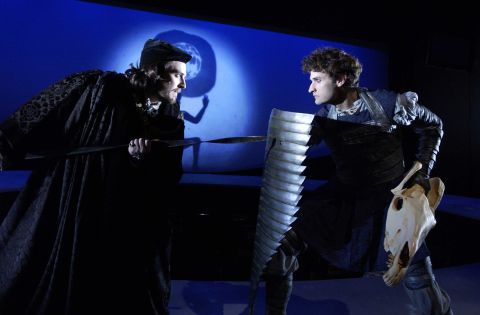|
<< -- 2 -- Robert Hugill AN ENTRANCING EVENING

The rear of the stage was enlivened by atmospheric video projection and by shadow animation, a highly effective way of encompassing some of the trickier requirements of the opera's stage directions. Cordelia Chisholm's costumes were roughly traditional, with faintly exotic touches for Angelica and Medoro, the two characters who come from the east.
Orlando's armour was perhaps the least successful, as it was represented by silver coloured bindings. The result was not very flattering but was most effective when Orlando's costume gradually unravelled along with his mind. It helps of course that counter-tenor William Towers has an imposing stage presence, sufficient to overcome any costume defects. Towers made a believable knight. He has an attractive, soft-grained voice that was displayed well in the small space of the Bayliss Studio. He made a convincing love-lorn knight and looking suitably broodlingly Byronic.

Nicholas Warden (Zoroastro) and William Towers (Orlando). Photo © 2006 Robbie Jack
|
But this was a role written for the great Senesino, so Orlando gets two rather martial arias. In these, Towers was unable to create the real trumpet tones that the arias require -- few counter-tenors can. But he responded with sheer technical brilliance; singing the bravura vocal lines at brisk speeds, he managed to be both virtuoso and expressive.
The great novelty in this opera is Orlando's mad scene, a sequence of short recitatives and arias which owes something to the earlier 17th century English mad scenes. The music eschews the virtuoso brilliance of the 19th century Italian mad scene, but Towers and director Talevi managed to combine expressive singing with a well-projected visualisation of Orlando's mad state.
Continue >>
Copyright © 15 November 2006
Robert Hugill, London UK

| 
